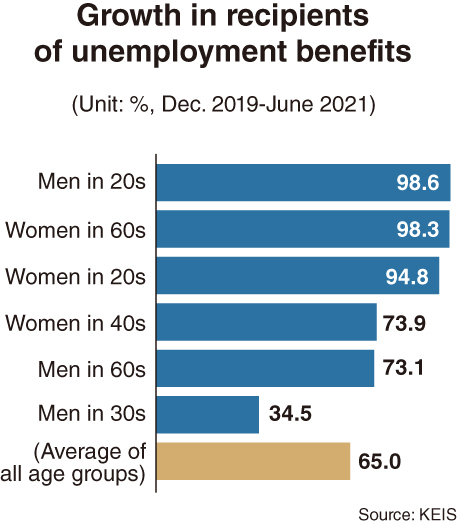
Applicants for unemployment benefits take a class at a regional office of the Employment and Welfare Plus Center in Seoul earlier this year. (Yonhap)
SEJONG -- The pandemic was found to have dealt tougher blows to young workers, women and the self-employed in South Korea in terms of job security, a state agency data showed.
According to the Korea Employment Information Service, the number of recipients of unemployment benefits among men in their 20s reached 41,814 last month. This marked a 98.6 percent surge from 21,051 in December 2019, a month before COVID-19 initially hit the nation.
The situation was similar among women in their 20s: a 94.8 percent increase from 34,163 to 66,566 over the corresponding period.
Since early 2020, many enterprises have reportedly pushed for layoffs of employees in their 20s with short careers and relatively weaker expertise. In addition, retailers like convenience store owners have been more pessimistic in hiring part-timers in the wake of a drastic hike in minimum wages as well as the pandemic situation.
Women in their 60s were also one of the three age groups, which posted nearly 100 percent in growth, as the recipient tally climbed by 98.3 percent from 34,034 to 67,505.

(Graphic by Kim Sun-young/The Korea Herald)
Given that the statutory retirement age is 60 for most jobs in Korea, a dominant portion of the female recipients, aged 60-69, are estimated to have been contract employees or self-employed businesspeople before they lost their jobs.
These three age groups far outstripped the average growth, 65 percent, posted among all recipients in the Dec. 2019-June 2021 period.
Men in their 60s also outpaced the average as the number of recipients increased by 73.1 percent from 56,729 to 98,212, which suggests that both female and male self-employed or nonregular workers took relatively hard hit by the pandemic.
The self-employed can also enjoy unemployment benefits if their sales plunge percentage meets the ceiling by the government, as long as they had paid premiums for the state-operating Employment Insurance.
A seriousness lies in the fact that a growing portion of the young generation have become self-employed, like food retailers or coffee shop owners in recent years.
Though the government has offered young small business owners subsidies like loans with low interest rates, the uncertainty over their survival in the market could mount should a longer-than-expected pandemic phase continue.
The KEIS data also showed that the increase in recipient tallies was higher among women than men in most age groups.
While a 34.5 percent growth was recorded among men in their 30s, women in their 30s posted 57.6 percent. Likewise, figures were 42.9 percent (men) vs. 73.9 percent among those in their 40s; and 45 percent (men) vs. 59.1 percent among those in their 50s.
The monthly payout balance for those who lost jobs, has remained over 1 trillion won ($866 million) in recent months, which contrasts to 624 billion won in December 2019.
More and more researchers raise the possibility that state reserves for payouts for the jobless might deplete on a midterm basis amid continuous renewal of all-time highs in monthly or yearly payment balances.
According to the KEIS, the government paid out 1.13 trillion won in unemployment benefits for Koreans in June 2021.
The monthly payouts for the jobless made a big jump from 462 billion won in June 2017 to 584 billion won in June 2018, 706 billion won in June 2019 and 1.1 trillion won in June 2020.
By Kim Yon-se (kys@heraldcorp.com)







